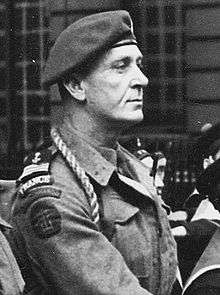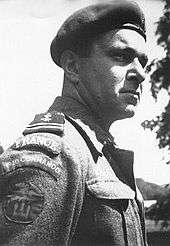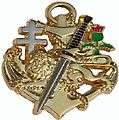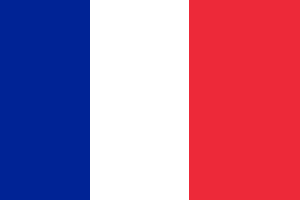Commandos Marine
| Commandos Marine | |
|---|---|
|
Commando beret badge | |
| Active | 1947–present |
| Country |
|
| Branch |
|
| Type | Navy Commando |
| Role |
Special Operations Counter Terrorism Direct Action Long-range reconnaissance Special Reconnaissance Joint terminal attack controller Underwater demolition Amphibious Warfare |
| Size | ~ 600+ SOF Operators |
| Garrison/HQ |
Lorient Saint-Mandrier-sur-Mer |
| Nickname(s) | bérets verts (green berets) |
| Mascot(s) | Jean-Louis |
| Commanders | |
| Current commander | RADM Olivier Coupry |
| Notable commanders |
CDR. Philippe Kieffer LCDR Victor Servent |
| |||||||||||||||||||||||||||||
The Commandos Marine are the special operation forces of the French Navy. They are made up of some 600 members plus support, mostly based in northwestern France (Brittany), with several bases across the country for specific training needs. The Commandos Marine are nicknamed bérets verts (Green Berets). They operate under the Naval Riflemen and Special Operations Forces Command (FORFUSCO) and form part of the French Special Operations Command.
History
The Commandos Marine were formed in 1942 during World War II, in the United Kingdom and were modelled on the British Commandos (who were founded in 1940). They were formed from Free French volunteers from different services, mainly from Navy Fusiliers Marins (Naval Infantry), other Navy specialities and even from the Army. They were trained at the Commando Training Centre Achnacarry, in Scotland and joined the No. 10 Commando (Inter-allied) as the 1st and the 8th Troops. To commemorate this, the beret of the French naval commandos is worn pulled to the right with the badge worn over the left eye or temple, the opposite of all other French military units.

The 1st BFMC (Battalion de Fusiliers Marins Commandos, Commando Naval Riflemen Battalion) took part in the Normandy Landing on D-Day under the command of Lieutenant Commander Philippe Kieffer, on SWORD beach, and were for the occasion integrated in No. 4 Commando. They further participated in the Netherlands campaign, still associated with No. 4 Commando. When the British Commando Units were disbanded at the conclusion of World War II, the two French Troops (forming the 1st BFMC) were repatriated to France to relieve in position the 1st RFM (1st Naval Infantry Regiment) departing for Indochina. Most of them demobilised or returned to their services (Army or other Navy specialities) but Commander Philippe Kieffer made the case to the French Ministry of the Navy that a Commando Corps was a capacity required to counter the guerrilla warfare in Indochina. The surviving members of the 1st BFMC formed the core leadership and the cadres for the Commando Training School to be created in Algeria in 1946 (Siroco Center, Matifou Cape).
Another branch comes from a Naval Reconnaissance Unit created in December 1944, Company NYO, formed from volunteers from different parts of the Navy, mainly Naval Riflemen (Fusiliers Marins) and Naval Artillery. This unit later renamed as Company Merlet (the name of its founder and commanding officer, Lieutenant (Navy) Jean Merlet), fought in Italy before embarking for Indochina in September 1945. It was renamed Company Jaubert, then naturally became Commando Jaubert, the first unit to be constituted as Commando when the French Navy decided to create a Commando Corps in 1946.
Commander Pierre Ponchardier and his Special Air Service Battalion aka SAS-B (also nicknamed Tigers Commandos), created in early 1945, fought in Indochina until 1946 before the battalion was disbanded. Ponchardier was a visionary of modern SOF. Although he was not subordinated to a Naval Rifleman chain of command, he ran large-scale operations in conjunction and with the support of Compagnie Merlet/Jaubert and the 1st RFM. His audacity, the innovation of the TTPs and the course of actions he applied in guerrilla warfare and COIN set the spirit and were disseminated to the overall Commandos Marine organisation.
By a 19 May 1947 decision, the Ministry of the Navy decision created five "Commando Marine" units, organised and designed as the former British Commandos. The French Navy transformed several Fusiliers Marins companies (Naval Riflemen) already combatting in Indochina (including Company Jaubert) or based aboard French Navy destroyers (to become Commando Trepel and Commando de Penfentenyo) and gradually renewed their personnel with commando-qualified recruits after the Siroco Center (commando course) was commissioned. Commando Francois and Commando Hubert were formed from scratch. Although Commando Jaubert was already trained for parachute and airborne operations, Commando Hubert became the official paratrooper commando unit for the French Navy. For this reason, they integrated by preference and priority former Ponchardier SAS-B members, who were already jump qualified.
Each Commando Marine bears the name of an officer killed in action during the World War II or during the Indochina campaign:

Captain Charles Trepel was an Army officer (artillery), Free French Forces; commanding officer of the 8th Troop (French), No. 10 Commando (Inter-allied). MIA/KIA 28 February 1944 during a night reconnaissance raid in Wassenaar, the Netherlands.

Lieutenant Augustin Hubert was an Army officer (infantry), Free French Forces; platoon leader in the K-Gun Troop (French) operating in support of Troop 1 and 8 (French) integrated for D-Day to the No. 4 Commando. He was killed 6 June 1944, in the first hour of combat, when the French Troops were maneuvering to seize the Casino of Ouistreham on SWORD Beach (France, Normandy).
Commander Francois Jaubert was a Naval Rifleman officer, commanding the Riverine Flotilla in Indochina, severely wounded during a joint operation with Compagnie Merlet, Ponchardier SAS-B and the 1st RFM and his Flotilla. He died of his wounds 25 January 1946.
Lieutenant (junior grade) Alain de Penfentenyo was a Navy officer, commanding officer of an LCVP platoon, killed in action during a riverine raid on the Donai river, 14 February 1946 (Indochina).
Lieutenant (junior grade) Louis de Montfort was a Company Merlet platoon commander. After his commander was wounded and evacuated de Montfort took command and was killed leading the company in Haiphong, 26 November 1946 (Indochina).
Lieutenant Jacques Francois was a Navy officer, commanding the 1st Amphibious Flotilla North. He was killed leading his unit, 6 January 1947 on the Nam-Dinh-Giang river (Indochina).
Commando Francois suffered dramatic losses on 29 May 1951 when it faced the attack of the 308th Vietminh division in Ninh-Bihn (Indochina). Only 29 survived, 5 were taken prisoner for months, 40 were killed and 9 were declared missing in action. Their sacrifice disrupted the surprise effect and unveiled General Giap's plans for the battle of Day. It gave French General de Lattre time to organise his counterattack. This commando Unit was further disbanded in May 1953.
Commando Hubert officially became a combat swimmer unit on 30 March 1953. It was a joint unit composed of Navy and Army (SDEC, secret service) combat swimmers. The army branch further separated to establish their base in Aspretto, Corsica (France).
Commando Kieffer was created 6 June 2008 in Ouistreham (Normandy, SWORD beach) during the D-Day commemoration ceremony.
Recruitment and training
Most of the recruits must have completed the Fusiliers-Marins Basic Training and served at least nine months of service. They have to enter a special forces basic training course, called Stage Commando (commando training) and reputed to be one of the toughest among the NATO Special Operation Forces. In 2016, the Stage Commando had an attrition rate of 82%.[1] The SOF Basic Training is open to sailors or enlisted from other Navy specialties. Commando Kieffer recruits specialists and experts from other specialties in the Navy or other services. They must go through the same training pipeline to earn the green beret and be deployed overseas.
Commando training is the gateway to the Special Operations Forces for the Naval Riflemen. Conducted at the Fusilier Marins school at Lorient on the Atlantic coast, it provides upon successful completion entry to the commandos and the right to wear the green beret. Lasting 20 weeks, it includes one week of commando testing, six weeks of screening and preparatory training, four weeks of evaluation, the actual SOF course for seven weeks, and two weeks of parachute training. During this period, any mistake can instantly disqualify the candidate. The ultimate goal of this training is to detect individuals with the physical, intellectual and psychological potential needed to serve in the Commandos Marine. The historical roots of commando training date back to the Second World War, when Fusilier-Marins volunteers from the Free French Navy went to the Commando training center in Achnacarry, Scotland. Since then, the Commandos Marine have kept by tradition the green beret pulled right with the bronze shield badge on the left, the only such exception in the French armed forces. They have retained the principle of exceptional training without compromise, based on immersion in a highly stressful environment, close to the conditions of combat operations.
The prospective Commandos in training are constantly under stress and pressure from instructors leaving them no respite. All activities are timed and scored: marching tens of kilometers with equipment and weapon in all weathers, obstacle courses and night navigation exercises. The training is punctuated by firearms training and assault tactics, climbing and rappelling, boat handling, explosives instruction and hand-to-hand combat. The instructors are experienced operatives assigned to the Commando School who monitor and punish failure with extra-hard physical activity.
The Commandos Marine have evolved to be broadly comparable to the British Special Boat Service.
Composition
Their personnel are distributed between seven Commando Units (squadron+ size), named after former commando officers killed in action, and are dedicated maritime counter-terrorist units :
| Insignia | Team | Deployment | Number of Platoons | HQ | Notes |
|---|---|---|---|---|---|
 | Commando Jaubert | Worldwide | 5 Platoons | Lorient, France | Direct Action, Assault at sea and on land, hot extraction, close quarters battle at sea and on land. Equal capabilities in the land and maritime Counter Terrorism (CT) roles. |
 | Commando de Montfort | Worldwide | 5 Platoons | Lorient, France | Reconnaissance, Intelligence Operations, Long Range Neutralisation (SKIT), JTACs comprises a Tier One platoon named ESNO. |
 | Commando de Penfentenyo | Worldwide | 5 Platoons | Lorient, France | Reconnaissance, Intelligence Operations, Long Range Neutralisation (SKIT), JTACs comprises a Tier One platoon named ESNO. |
 | Commando Trepel | Worldwide | 5 Platoons | Lorient, France | Direct Action, Assault at sea and land, hot extraction, close quarters battle at sea and on land. Equal capabilities in the land and maritime CT roles. |
 | Commando Hubert | Worldwide | Classified | Toulon, France | (also named Commando d'Action Sous-Marine Hubert, CASM, "Underwater Operations Commando"): Underwater action (combat divers). Appears to be a Special Mission Unit in support of land and maritime Counter Terrorism roles. |
 | Commando Kieffer | Worldwide | Classified | Lorient, France | C3I, Combat dogs K9, CP CBRN, UAVs, Intel, TTPs and Procedures Development. |
 | Commando Ponchardier | Worldwide | Classified | Lorient, France | Support and supply for all Commandos Marine. |
-

Commando Hubert personnel transition over a beach.
-

Commando Jaubert personnel storm the Alcyon in a mock assault.
-

Members of the Commando Jaubert covering each other.
-

U.S. Army Special Forces and French Commandos Marine conduct a reconnaissance patrol during a joint-combined exercise in Djibouti.
-
A member of the Commandos Marine during a ceremony.
-

Beret and badge of the Commandos Marine.
See also
- List of French paratrooper units
 United Kingdom- Special Boat Service
United Kingdom- Special Boat Service Germany- German commando frogmen
Germany- German commando frogmen United States- Navy SEALs - NSWDG
United States- Navy SEALs - NSWDG Denmark- Frømandskorpset
Denmark- Frømandskorpset Netherlands- Korps Mariniers - Maritime Special Operations Forces
Netherlands- Korps Mariniers - Maritime Special Operations Forces United States- Force Recon
United States- Force Recon United States- MARSOC - Critical Skills Operator
United States- MARSOC - Critical Skills Operator

